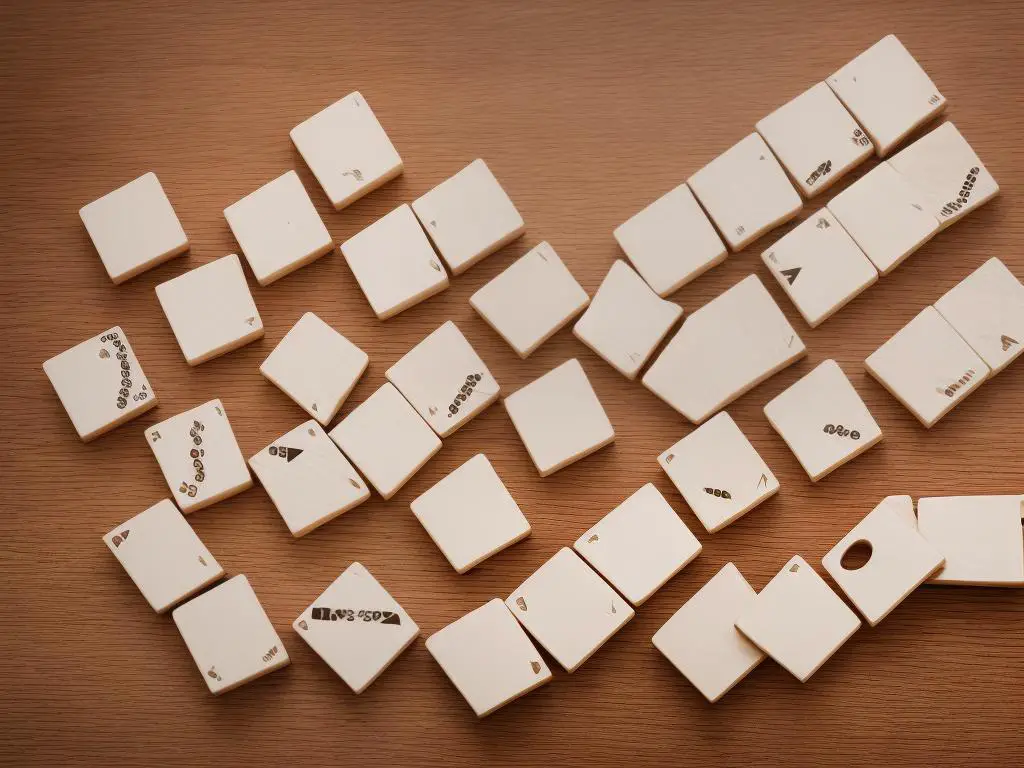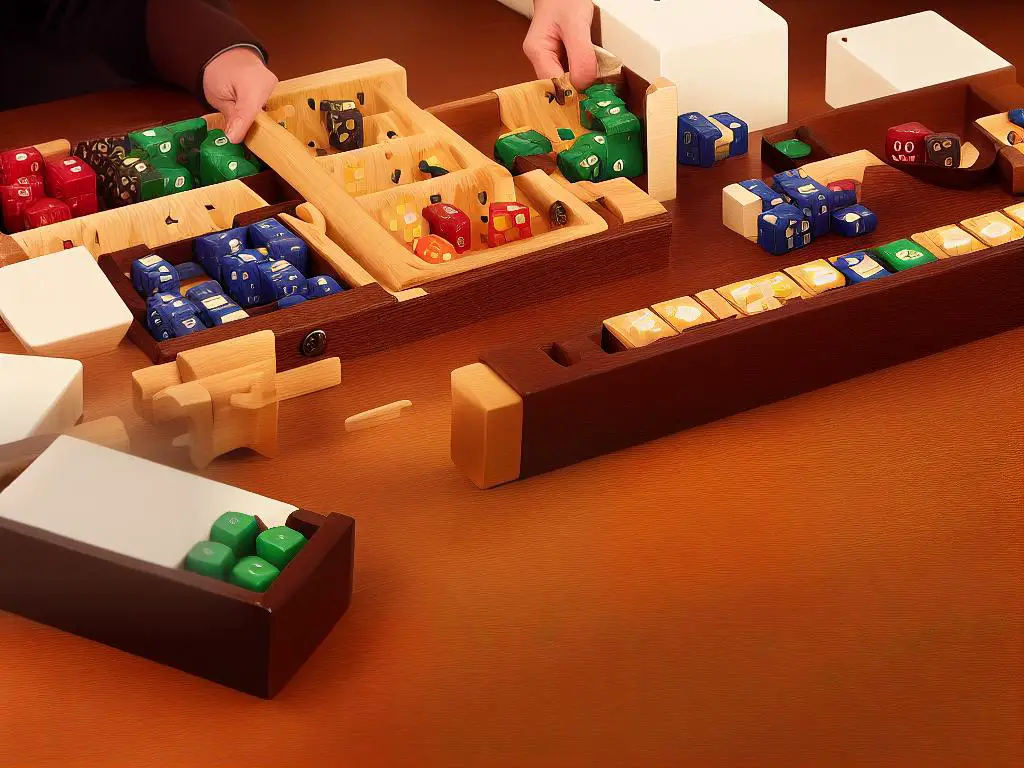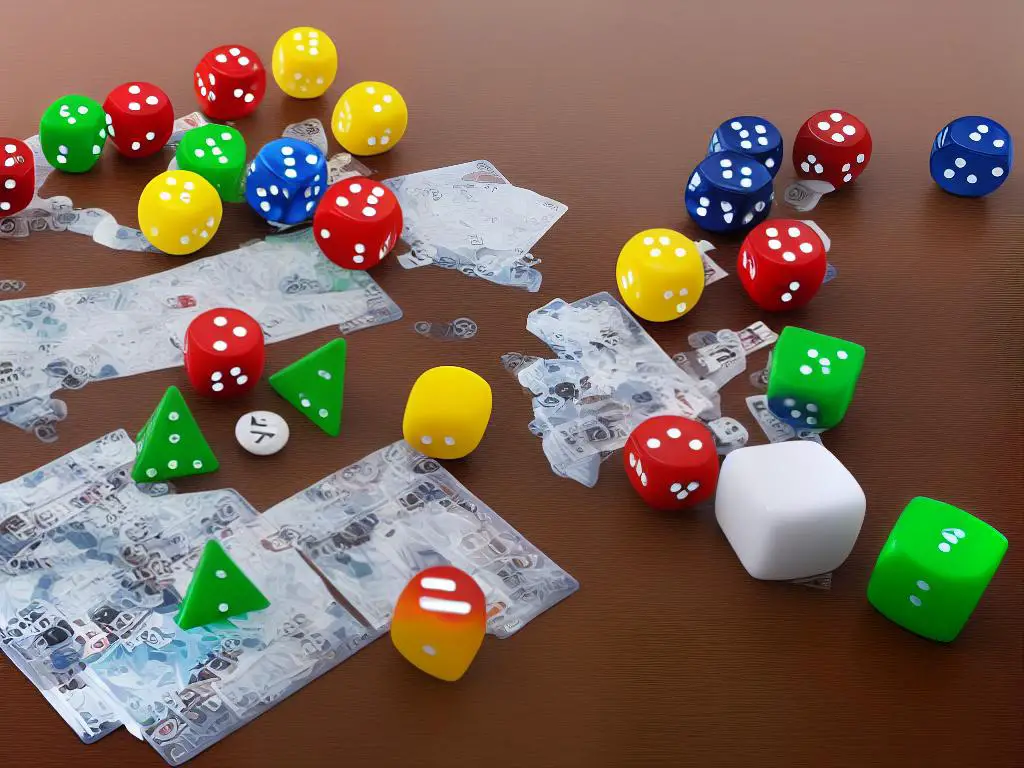Welcome to the exciting world of Shut the Box! This classic game of chance, strategy, and luck has captivated players for centuries. Whether you’re a complete beginner or an experienced player, this comprehensive guide will provide you with all the necessary information to understand the game, develop your skills, and have fun along the way.
This article contains Amazon affiliate links. I will earn a small fee if you use one of these links to make a purchase. It will not increase the price you have to pay!
If you would like to purchase a version of Shut the Box, you can do so here from Amazon!
Understanding Shut the Box Game Rules
Objective of the Game:
The goal is to close or “shut” all the numbered tiles or flaps (usually between 1-9 or 1-12) in the lowest number of turns to achieve the lowest accumulated score. The player with the lowest score at the end of the game wins.
Setting Up:
The game requires a shut the box board (a wooden box containing numbered tiles or flaps and two dice), ideally with numbers ranging from 1 to 9 or 1 to 12. Each player must have a pen and paper to track their scores.
Basic Rules:
- Determine the order of play by rolling one die. The player with the highest number goes first, and play proceeds clockwise.
- At the beginning of their turn, each player opens all the numbered tiles or flaps.
- To start a turn, the player rolls both dice and adds their total value. Then, players must decide which combination of numbered tiles or flaps to close that equal the sum rolled. For example, if a player rolls a total of 5, they could close the “1” and “4” tiles, the “3” and “2” tiles, or just the “5” tile.
- Players continue to roll and close tiles until they cannot close any more tiles that match the dice’s rolled value. If the player cannot close any tiles, they must record the sum of the remaining open tiles as their score for that round. For example, if tiles 2 and 4 are still open, their score would be six.
- Once all players have completed their round, compare each player’s score. The player with the lowest score wins that round. If playing multiple rounds, keep a running total of each player’s score, and the player with the lowest overall score after all rounds wins the game.
Taking Turns:
In a traditional shut the box game, each player gets one turn per round. On their turn, they should close as many tiles as possible. However, some variations of the game allow for more than one turn per round, challenging players to strategize more effectively.
Closing the Box:
A player successfully “shuts the box” if they close all the numbered tiles during their turn. This is the best possible outcome, as the player achieves a score of zero for that round, putting them in the lead.
Variations and Additional Rules:
- If a player reaches a point where the sum of the remaining open tiles is six or lower, the player may choose to roll only one die for the rest of their turn. This option provides more chances to close the remaining tiles.
- In a “forced choice” variation, a player must close the tiles strictly in a left-to-right or right-to-left sequence. A roll that does not allow the player to close a tile in sequence will end the turn.
Now that you have a basic understanding:
of shut the box’s rules, start practicing with friends and family for a fun and engaging gaming experience. Remember, the key to success in this game lies in strategic thinking and calculated choices, making it all the more enjoyable to play.

Setting Up the Game
Shut the Box is a fun and engaging dice game that can be played by enthusiasts, hobbyists, and players of all ages. Whether you’re a beginner looking to learn the ropes or an experienced player, setting up the game properly is essential for an enjoyable experience. This guide will provide you with step-by-step instructions on setting up the game, detailing the required equipment and setup, as well as what type of box, dice, and tokens are needed for a smooth gameplay experience.
Materials Needed:
Step 1: Gather the equipment
Purchase or obtain a Shut the Box game set. Many game sets will include the wooden box, wooden tiles (usually numbered 1-9 or 1-12), and two dice. The box itself typically features a felt-lined playing surface to minimize noise and protect the box and dice.- If you don’t have a game set, you can make your own by creating a wooden box and tiles, and sourcing two 6-sided dice.
Step 2: Prepare the playing surface
Find a flat surface where you can comfortably setup and play the game. Think of surfaces such as a table, countertop or the floor. Make room for the game and ensure that the dice can be easily rolled without hitting any obstacles.
Step 3: Organize the box and tiles
Place the wooden box on the playing surface with the tiles in their designated slots. Each tile should be numbered from 1 (on the left) to 9 or 12 (on the right), depending on your game set.- Make sure all the tile numbers are face-up and clearly visible to all players.
Step 4: Place the dice nearby
Take the two 6-sided dice and place them near the box, easily accessible for all players to pick up and roll during the game.
Step 5: Set up scorekeeping (optional)
Normally I just play for fun, however, If you wish to keep track of scores, have a pen and paper handy to record each player’s points after each round!
Step 6: Play the game!
Invite friends or family members to join you in playing Shut the Box. Happy gaming!

Developing Basic Strategies
Shut the Box is an entertaining game with a mix of luck and strategy. With practice and understanding, you can increase your chances of winning by employing some key strategic moves. Follow these instructions to develop basic strategies for improving your Shut the Box gameplay:
- Familiarize yourself with the game rules: To strategize effectively, you need to fully comprehend the rules of Shut the Box. This will help you in making informed decisions throughout the game. Make sure you know the layout, the number of tiles, and the mechanics of rolling the dice.
- Target numbers: It is essential to identify specific numbers on your tiles and consider their importance. Since you need to cover all your tiles’ numbers, having a target number in mind can help structure your gameplay. For instance, consider targeting the numbers 6, 7, and 8 as they have the highest probabilities due to the various combinations of dice rolls that result in these numbers.
- Optimal dice rolls: Understanding the probability of dice rolls is crucial for creating a successful strategy. Keep in mind that combinations that result in 6, 7, and 8 are the most common. By aiming to flip tiles with these numbers, you increase your odds of covering them and closing the box.
- Tile flexibility: Maintain flexibility with your tile choices when a certain number can be achieved with multiple tile combinations. By keeping a variety of tiles available, you allow yourself more options when rolling the dice. For example, if you roll a 6 and have the option to flip either the 6 or the 1 and 5, decide which choice will leave you with more flexibility for your next roll.
- Anticipate future rolls: As you play more rounds, you will start to notice patterns and combinations that work better than others. Use this knowledge to anticipate future rolls and plan accordingly. For example, if a certain combination of tiles tends to leave you with a specific difficult roll, try to avoid that combination if possible.
- Adapt your strategy to your opponent: If you’re playing against others, pay attention to their strategies and tactics. Observe the combinations they use and the numbers they target, as this information can help you adapt your own approach to counter their game plan.
- Practice, practice, practice: Becoming a skilled Shut the Box player takes time and experience. The more you play, the more strategies you will learn, and the better you will be at picking up on patterns and adapting to unexpected rolls of the dice. Practice regularly to improve your skills, be patient, and enjoy the game.
By following these steps, you should be well on your way to developing successful strategies and increasing your chances of winning at Shut the Box. Remember, practice is key, and the more you play, the better you’ll understand the game and the tactics that work best for you. Good luck!

Game Variations
Shut the Box Game Variations
Shut the Box is a classic game that is traditionally played with two dice, a specially-made box, and numbered tiles or levers representing the numbers 1 to 9. However, there are many variations to this game that you can experiment with for added fun and excitement. Here are some alternative scoring systems, gameplay formats, and ways to play with more players:
1. Alternative Scoring Systems
a. Reverse Scoring: In this variation, the player with the highest score wins. To play, each player starts with a score of zero. After each turn, the remaining numbers on the tiles are added to the player’s score. This means that a player must keep as many tiles open as possible to achieve a high score.
b. Time-Based Scoring: In this variation, the game is played for a set amount of time, and the player with the lowest score at the end of the time wins.
2. Gameplay Formats
a. Forced Moves: This variation adds a strategic element to the game. Before starting, players decide on the number of dice rolls they have to use to close as many tiles as possible (for example, 6 rolls). Players can then choose when to use their dice rolls, strategically deciding when to close specific tiles.
b. Odd and Even Tiles: For this variation, you separate the tiles into two groups (odd numbers 1, 3, 5, 7, 9, and even numbers 2, 4, 6, 8). Players roll to determine which group they must close out first. They must first close out all the tiles in the chosen group before attempting to close the remaining tiles.
3. Play with More Players
a. Team Play: Divide the players into two teams. Each player on the team takes a turn rolling the dice and shutting tiles. The goal is to be the first team to shut all the tiles in the box. Players must employ teamwork and strategize together to close the tiles efficiently.
b. Relay Shut the Box: Players form a circle, and each is given a certain number of turns to shut as many tiles as possible in their box. After their turns, they pass it to the next player, who does the same. The game continues until all players have had a turn, and the player or team with the lowest score wins.
c. Tournament Style: This variation works well for a larger group. All players participate in a tournament bracket, with one-on-one games leading to elimination rounds. The winner of each game progresses to the next round until the final champion emerges.
Now that you are familiar with these different variations of Shut the Box, gather a group of friends, and enjoy hours of fun trying out these alternative gameplay styles. These variations not only test your luck but also challenge your strategic thinking and add fun for both newcomers and experienced players alike.

Building Your Own Shut the Box Game
Shut the Box is a classic dice game that is sure to be a hit at family gatherings and game nights. With simple rules and a design that can be easily customized, learning how to build your own Shut the Box game is a great way to add a personal touch to your next game night. This guide will show you how to create a basic Shut the Box game from scratch using materials and tools you can easily find around your home.Materials:
– Wooden board (such as plywood, at least 12 inches by 9 inches), but dimensions can vary depending on your preference
– Wooden dowels or square stock (approximately 1/2 inch by 1/2 inch and a minimum of 3 feet in length)
– 12 wooden tiles numbered 1 to 12 (you can craft these yourself or purchase pre-made tiles)
– Wood glue
– Two dice (standard six-sided)
– Sandpaper
– Pencil
– Ruler
– Saw (hand saw, jigsaw, or miter saw)
– Paint or wood stain (optional)Instructions:
1. Prepare the wooden board: Begin by sanding the wooden board to remove any rough edges or unwanted marks. If desired, you can paint or stain the board at this point. Allow the finish to dry completely before proceeding.
2. Cut the wooden dowels: Measure and mark your dowels to create twelve equal sections, each about 3 inches long. Use a saw to make clean cuts on each dowel section. Sand the cut ends to ensure a smooth finish.
3. Create the numbered tiles: If crafting your own tiles, measure and cut twelve small wooden rectangles from the remaining dowel material. Sand the edges of each tile until smooth. Paint or stain the tiles if desired, and use a stencil or freehand method to add numbers 1 through 12 to the top face of the tiles. Allow the paint to dry completely.
4. Arrange the numbered tiles: Place the tiles in a horizontal line across the center of the wooden board, ensuring that they are evenly spaced and in numerical order. This will create a visual guide for attaching the dowels in the next step.
5. Attach the dowels: Apply a thin line of wood glue to one cut end of each dowel section. Position the glued end behind each corresponding numbered tile and press onto the wooden board, ensuring the dowel is affixed flush against the edge of the tile. Allow the glue to dry completely before proceeding.
6. Create dividers (optional): If you want to keep the numbered tiles more securely separated, measure, cut, and glue thin wooden strips between the dowels, perpendicular to the tile row. Allow the glue to dry completely.
7. Add finishing touches: Once the assembled Shut the Box game is dry, examine the construction for any rough edges or spots requiring additional sanding. Optionally, you can seal the game surface with a clear protective finish to preserve your design and ensure a smooth playing surface.Your Shut the Box game is now complete and ready for playing! Just grab a pair of six-sided dice and you’re set for a fun, engaging game experience. Enjoy!

Playing Online or in Apps
Playing Shut the Box Online or in Apps – A Guide for Enthusiasts and Hobbyists
Shut the Box is a very popular traditional game that’s typically played with a box, a pair of dice, and numbered tiles. The goal of the game is to shut (or cover) all of the numbered tiles by rolling the dice and using various strategies. If you’re looking for ways to play this fun game online or through a mobile app, this guide is for you!
We’ll explore various options for playing Shut the Box through online platforms or mobile apps and compare the advantages and disadvantages of each. Let’s get started!
1. Browser-Based Online Games:
There are several websites that allow you to play Shut the Box directly from your browser. Popular examples include:
- 247Game’s Shut the Box (https://www.247games.com/html5/games/shut-the-box/): Plays on computers, laptops, and mobile devices, and it’s available without sign-up.
Advantages:
- No need to download and install any software
- You can play the game from any device with internet access
- Usually free to play
Disadvantages:
- You may encounter ads on some websites
- Limited features and customizations compared to mobile apps
2. Mobile Apps:
There are various mobile apps available on the Apple App Store and Google Play Store to play Shut the Box on your smartphone or tablet:
- Shut the Box Classic (iOS and Android): A simple and straightforward interface with customizable rules and difficulty levels.
- Can’t Stop: The Ultimate Risk (iOS): This app includes multiple classics like Shut the Box, Pig, and Can’t Stop, with detailed instructions for each game.
- High Rollers (Android): Offers a varied experience every time you play, as each numbered space has a unique objective.
Advantages:
- Easy-to-use interface and smooth gameplay experience
- You can play the game anytime, anywhere
- Many apps offer customizable rules and difficulty levels
Disadvantages:
- Storage space may be taken up on your device
- Some apps may require in-app purchases for full features or to remove ads
3. Social Media Platforms:
Some social media platforms allow you to play Shut the Box with friends, making the experience more enjoyable:
- Facebook Messenger: It’s easy to invite friends to play a game of Shut the Box and challenge them to beat your high scores.
Advantages:
- Play with friends and enjoy the competitive experience
- Discover and chat with new people who share your enthusiasm
Disadvantages:
- Limited gameplay options compared to dedicated apps or websites
- Privacy concerns and data usage while playing on social media platforms
Conclusion:
There are plenty of options for playing Shut the Box online or through mobile apps, each with its own set of advantages and disadvantages. Browser-based games provide a simple and quick way to start playing, while mobile apps generally provide a more customizable and immersive experience. Social media platforms such as Facebook Messenger allow you to challenge your friends and interact with other players.
Choose the platform that suits your preferences, and enjoy the fun and excitement of playing Shut the Box!

Advanced Strategies
Shut the Box is a simple yet intriguing game enjoyed by both casual gamers and math enthusiasts. While the basic concept of the game is easy to grasp, there are advanced strategies that can be employed to improve your odds of winning. In this guide, we will explore probability, risk assessment, and challenging tactics to enhance your Shut the Box gameplay.
1. Understand the mechanics and probabilities
Before diving into the strategies, it’s important to understand the mechanics of the game and the probabilities associated with each roll. Shut the Box is typically played with two dice, meaning there are 36 possible combinations (6 faces on each die). Familiarize yourself with these combinations and their frequency of appearance.
2. Develop a strong opening move
Having a strong opening move is essential in Shut the Box. One effective opening tactic is to try to shut as many high-value boxes as possible. This increases the chances of shutting lower-value boxes later in the game when it becomes more difficult to roll high numbers. For example, if you roll a 9 on your first turn, it’s better to shut the 9 box instead of 6 and 3 or 5 and 4.
3. Assess the value of each roll
In Shut the Box, each roll has a value determined by the combination of boxes it can potentially shut. In general, rolls with higher values are more advantageous. Developing a methodology to assess the value of each roll will help you make informed decisions about which boxes to shut.
For example, if you roll a 7 with available boxes 1, 2, 4, 6, and 7, calculate the value of each possible move:
– Shutting the 7 box = 1 move
– The 6 and 1 boxes = 2 moves
– Shutting the 4, 2, and 1 = 3 moves
In this scenario, shutting the 4, 2, and 1 boxes is the best move since it offers the most value.
4. Focus on maintaining balance
Keeping a balance between low and high-value boxes is essential for ensuring you have options later in the game. If you shut too many high-value boxes initially, you’ll struggle to roll high numbers later on. Similarly, shutting too many low-value boxes leaves fewer combinations for rolling lower numbers. Strive to maintain a balance between both sides to improve your chances of success.
5. Make the most out of forced moves
Sometimes, particularly in later turns, you will be forced to make a move due to the available boxes and your dice roll. Always be mindful of these forced moves, and use them to your advantage by shutting the boxes that offer the most value and maintain a balanced board.
6. Incorporate risk assessment
While Shut the Box inherently involves an element of chance, assessing the risk of each move can help you make better decisions. Calculate the odds of rolling a specific number based on the remaining boxes and make moves that maximize the chances of future success.
7. Embrace challenging tactics
Challenge yourself by incorporating advanced tactics like forcing specific rolls, considering multiple turns ahead, and adapting your strategy based on the changing board. Developing these skills will not only enhance your gameplay but also stimulate your mathematical and analytical mind.
By understanding the probabilities, incorporating risk assessment, and embracing challenging tactics, you can transform your Shut the Box gameplay from casual fun to advanced strategy. Develop your skills and strategy to become a master of this captivating game.

With your newfound grasp of Shut the Box, we hope you enjoy exploring its various facets and engaging with the community that shares your passion for the game. By applying the strategies and insights offered in this guide, you’ll be well-equipped to both build a custom game set and dive into the digital world of online play. So take a chance, roll the dice, and embrace the countless possibilities that Shut the Box has to offer.
Frequently Asked Questions
Q: What is Shut the Box?
A: Shut the Box is a dice-based game played with numbered tiles or wooden flaps. The objective is to flip down all the flaps by rolling the dice strategically.
Q: How many players can participate in Shut the Box?
A: Shut the Box can be played with one or more players, making it suitable for solo play or group entertainment.
Q: What are the basic rules of Shut the Box?
A: Players take turns rolling the dice and flipping down the flaps that correspond to the rolled numbers. The sum of the remaining unflipped numbers becomes the player’s score.
Q: Can you explain the scoring system in Shut the Box?
A: In Shut the Box, the objective is to achieve the lowest score possible. At the end of each round, the player’s score is the sum of the unflipped numbers on the remaining flaps.
Q: Are there any strategies or tips for playing Shut the Box?
A: Some strategies include prioritizing the elimination of higher-numbered flaps, managing probabilities based on the dice roll, and optimizing decision-making to minimize the final score.
Q: Are there different variations of Shut the Box?
A: Yes, Shut the Box has various versions, including traditional and modern variations with different flap configurations, scoring rules, and additional gameplay elements.
Q: Is Shut the Box suitable for children?
A: Yes, Shut the Box can be enjoyed by children and adults alike. It helps develop math skills, decision-making, and strategic thinking.
Q: Where can I find more game guides and resources? A: For more game guides and resources, visit CardsAndBoards.net. Explore our collection of entertaining games for endless fun!